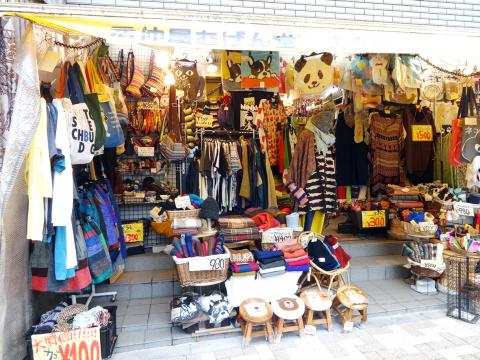Visitors looking to spend a few hours away from the tourist attractions of central Tokyo might consider taking the train to Kichijoji. Along with the usual department stores and chain retailers like Uniqlo that cluster around large Tokyo train stations, the neighborhood is home to smaller shopping areas, some uniquely Japanese, and a major park.
The JR Kichijoji train station is west of central Tokyo on the Chuo line, one stop away from the popular Ghibli Museum. The museum is devoted to the work of Studio Ghibli, which is known for animated movies including My Neighbor Totoro and the Academy Award-winning Spirited Away.
As you head from the station toward Inokashira Park, you’ll find cute shops with a youthful vibe selling clothes and knickknacks on side streets. Restaurants offer outdoor seating, which isn’t common in Tokyo. You’ll actually have to look a bit for Japanese food in this part of the neighborhood, but one good choice is on the left as you head into the park: Toriyoshi, which has an English menu and specializes in yakitori (grilled chicken skewers). Nearby cafes specialize in French toast, waffles or crepes, and French and Italian food. At a Starbucks, locals hang out with their dogs and babies.

Photo: AP
A flight of stairs leads down into Inokashira Park, full of big trees around a pond, where you can rent pedal boats and see street performers on weekends in nice weather. The park is also a good spot for viewing cherry blossoms in season.
Follow the bridge over the pond to a small zoo. The first section is mostly birds; it’s a bit of a hike to the rest of the zoo, but it’s a nice walk. Visitors from places where squirrels roam freely might be surprised to find squirrels living here in a walk-through enclosure. Admission to the zoo is US$3.35 for adults and a small amusement park area has rides for children.
For a traditional Japanese shopping experience, on the other side of the station look for tall blue-green metal framework. This is the Sun Road shotengai, a shopping street covered by an arcade. It’s like a shopping mall unrolled into one long row but a bit more practical, selling everything from eyeglasses to vegetables. Shotengai are fading in some parts of Tokyo, but this one is modernized and vibrant. You’ll find boutiques, discount shops, shoes plain and fancy, books, coffee places, all kinds of clothing, drugstores, and restaurants, with more Japanese food in this area than other parts of the neighborhood. You can get an English brochure about the broader area at a tiny tourism booth (blink and you’ll miss it) on the right.
For a trip back in time to the mid-20th century, don’t miss Harmonica Yokocho, a warren of narrow alleys full of tiny bars and restaurants that’s liveliest at night but worth a look any time of day. (The grid of alleys is said to resemble the reeds of a harmonica.) To find it, look to your left inside the Sun Road entrance; if you see tiny alleys that you’re not sure are public, that’s probably it. You can also access the alleys from the main road, directly across from the station. Some stores here are run by younger people, and boutiques are popping up. But there’s also an old, cheap clothing shop and fa restaurant with the dust of decades on its plastic curtain and paper lantern. That slightly scruffy atmosphere is part of the area’s charm.

In the March 9 edition of the Taipei Times a piece by Ninon Godefroy ran with the headine “The quiet, gentle rhythm of Taiwan.” It started with the line “Taiwan is a small, humble place. There is no Eiffel Tower, no pyramids — no singular attraction that draws the world’s attention.” I laughed out loud at that. This was out of no disrespect for the author or the piece, which made some interesting analogies and good points about how both Din Tai Fung’s and Taiwan Semiconductor Manufacturing Co’s (TSMC, 台積電) meticulous attention to detail and quality are not quite up to

April 21 to April 27 Hsieh Er’s (謝娥) political fortunes were rising fast after she got out of jail and joined the Chinese Nationalist Party (KMT) in December 1945. Not only did she hold key positions in various committees, she was elected the only woman on the Taipei City Council and headed to Nanjing in 1946 as the sole Taiwanese female representative to the National Constituent Assembly. With the support of first lady Soong May-ling (宋美齡), she started the Taipei Women’s Association and Taiwan Provincial Women’s Association, where she

Chinese Nationalist Party (KMT) Chairman Eric Chu (朱立倫) hatched a bold plan to charge forward and seize the initiative when he held a protest in front of the Taipei City Prosecutors’ Office. Though risky, because illegal, its success would help tackle at least six problems facing both himself and the KMT. What he did not see coming was Taipei Mayor Chiang Wan-an (將萬安) tripping him up out of the gate. In spite of Chu being the most consequential and successful KMT chairman since the early 2010s — arguably saving the party from financial ruin and restoring its electoral viability —

It is one of the more remarkable facts of Taiwan history that it was never occupied or claimed by any of the numerous kingdoms of southern China — Han or otherwise — that lay just across the water from it. None of their brilliant ministers ever discovered that Taiwan was a “core interest” of the state whose annexation was “inevitable.” As Paul Kua notes in an excellent monograph laying out how the Portuguese gave Taiwan the name “Formosa,” the first Europeans to express an interest in occupying Taiwan were the Spanish. Tonio Andrade in his seminal work, How Taiwan Became Chinese,